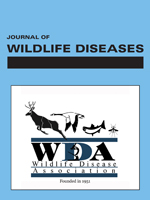Diagnostic findings are presented on 522 common loons (Gavia immer) found dead or moribund in New England (Connecticut, Maine, Massachusetts, New Hampshire, Rhode Island, and Vermont, USA) between 1987 and 2000. Common loon numbers and range in New England have decreased from historic levels over the last century due to a number of proposed factors. Goals of this study were to identify and categorize causes of mortality and quantify natural versus anthropogenic causes. The majority of identifiable mortality in chicks was from intraspecific aggression (25%) and other causes of trauma (32%). Death in immature loons was primarily from fungal respiratory disease (20%) and trauma (18%). Causes of adult loon mortality differed significantly in breeding and wintering habitats. Wintering adults primarily died of trauma (17%) and infection (11%) and had significantly poorer body condition than breeding loons. In breeding adults, confirmed and suspected lead toxicosis from ingested fishing weights accounted for almost half of all mortality. Direct anthropogenic factors accounted for 52% of loon mortality in this study. Because of high carcass recovery rates, we believe these data are a good representation of loon mortality in New England. Results highlight the importance of human influences on conservation and management of the common loon in New England.
How to translate text using browser tools
1 April 2003
MORTALITY OF COMMON LOONS IN NEW ENGLAND, 1987 TO 2000
Inga F. Sidor,
Mark A. Pokras,
Andrew R. Major,
Robert H. Poppenga,
Kate M. Taylor,
Rose M. Miconi

Journal of Wildlife Diseases
Vol. 39 • No. 2
April 2003
Vol. 39 • No. 2
April 2003
anthropogenic factors
Aspergillus
common loon
Gavia immer
lead toxicosis
New England
trauma




